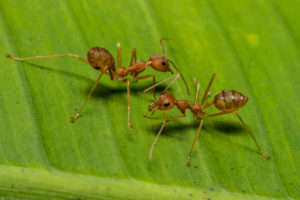
As summer comes to a close and fall is on the horizon, there are some common lawn pests to watch for.
There seems to be a widespread misconception that the end of summer also marks the collective end for any critters with a proclivity to wreak havoc on your yard. Unfortunately, plenty of species can survive the drop in temperature, continuing their destructive efforts throughout the cooler months. Follow along with this guide to learn the tell-tale signs of some of the more troublesome fall lawn pests, and what to do if you notice them cropping up.
1. Ants
These ubiquitous bugs won’t cause much lasting damage to your lawn, but they’re a pain nonetheless—especially the biting types! As less-than-subtle pests, ants will announce their presence with hills throughout your yard, and often by just strutting into your house en masse.
Chemical treatment: Bait traps tend to work better than pesticide sprays, as ants bring this poison back into the colony; it quickly spreads throughout, killing the queen and preventing the otherwise inevitable waves of future generations.
Natural remedy: Soak any nests for half an hour with your garden hose. It’s possible for ants to survive underwater for up to 24 hours, so be sure to repeat this process the next day
Preventative measures: Regularly place bait traps throughout your yard (keeping pet safety in mind), be careful about leaving any food around, and ensure that there aren’t any cracks in your foundation providing access.
2. Chinch Bugs
Adult chinch bugs are only about a tenth of an inch long, but can cause problems on a much bigger scale. These tiny fall lawn pests feed on your grass, and in the process secrete a substance that keeps it from properly absorbing moisture. So, indicators of a chinch infestation will come as irregularities in both the condition of your grass (dry/wilting) and irregularities of its coloring (yellow patches that become brown as they spread—or even a purplish tinge).
Chemical treatment: Any insecticide containing bifenthrin, carbaryl, or trichlorfon will be effective in eradicating chinch bugs, but always use these with caution due to the potential dangers exposure presents to person and pet alike.
Natural remedy: Applying diaphanous earth is the ideal solution, as it remains it’ll stay in your soil long enough to dehydrate/destroy both the crop currently creeping around and any gestating larvae.
Preventative measures: Proper lawn care! Keep your grass cut to the proper length suiting its type, don’t over-hydrate, etc.
3. Ticks
These rank among the more nefarious fall lawn pests, not so much for threats to your lawn’s health but your own (and your pets’): tick bites can transmit any number of serious illnesses and diseases. Apart from finding one on yourself or your furry friend, the only way to know they’ve taken up in your yard is spotting them there. Make a habit of being on the lookout.
Chemical treatment: At present, there’s no reliably effective chemical solution or yard treatment for ticks.
Natural remedy: Fortunately, both cedar oil and (diluted) eucalyptus oil will do the trick. Spray wherever you’ve seen ticks crawling around; the effect will be lethal to them, but completely harmless to pets.
Preventative measures: A well-kept lawn once again is the best repellant. Be sure to keep trees and bushes trimmed and remove dead leaves as necessary. If you live in deep woods, you may want to consider lining the perimeter of your lawn with mulch or gravel—a “dry moat” of sorts.
Have More Questions? Stay in Touch!
Order early and order often to ensure the best service possible. Contact us through our online page. Please find us at 27616 Little Lane, Salisbury, Maryland 21801. Our phone number is 410-726-6103, and our fax number is 410-742-6550. Speak to Jason Anderson for Turf Grass Sales. Reach him by email at jason@quanticocreeksod.com. Finally, follow us on social media on Facebook, LinkedIn, and our blog!
